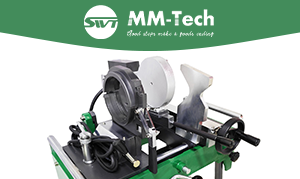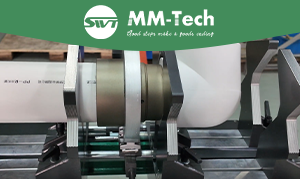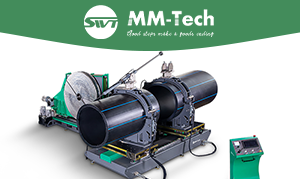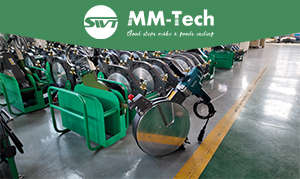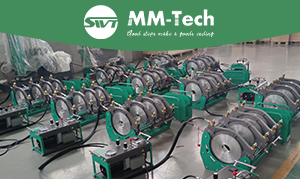A PE welding machine joins pipes in modern piping systems, ensuring strong and leak-proof connections. Reliable joints remain vital for water, gas, and industrial networks.
The table below highlights the growing importance of these machines:
Aspect | Details |
|---|---|
Key Application Areas | Water and gas distribution networks needing leak-proof joints |
Market Growth Drivers | Infrastructure development, urbanization, government initiatives |
Technological Advancements | Automation, IoT, AI integration improving efficiency |
Butt fusion, electrofusion, and socket fusion machines serve diverse pipe welding needs. MM-Tech stands out for innovation and quality in this field.
Key Takeaways
PE welding machines create strong, leak-proof joints essential for safe and durable water, gas, and industrial piping systems.
Modern machines use automation and smart features to improve welding accuracy, boost productivity, and reduce errors.
Choosing the right machine and proper operator training ensure reliable pipe connections and long-lasting performance.
PE Welding Machine Basics
What Is a PE Welding Machine?
A PE welding machine is a specialized device designed for joining thermoplastic pipes, especially those made from polyethylene. These machines play a crucial role in creating strong, leak-proof connections in piping networks. MM-Tech, a leading manufacturer, produces advanced machines that help professionals achieve reliable results in various pipe systems.
Precise control during welding is essential. Timing errors account for about 35% of HDPE pipe problems, showing how important accuracy is in the process.
A PE welding machine uses heat and pressure to fuse pipes together. This process ensures that the joint is as strong as the original pipe. Modern machines, like those from MM-Tech, often include features such as smart automation, advanced sensors, and data logging. These features help operators monitor and track the welding process, improving machine utilization by up to 25% and boosting productivity by at least 10%. Automation also reduces manual errors, making the joints more consistent and reliable.
Monitoring and tracking welding processes can improve machine utilization by 15% to 25%, which in turn boosts productivity by at least 10%.
Data logging features reduce liability and support repair processes by maintaining quality records.
Automation reduces manual errors, improving joint strength and consistency.
The electrofusion process melts HDPE pipes and fittings using an internal coil, creating joints as strong as the pipe itself without needing glue or external heat.
The process steps (preparation, heating, fusion, cooling) ensure even and strong bonds, preventing leaks and failures.
Electrofusion welding reduces installation time and costs compared to older methods, enhancing overall efficiency.
Modern machines provide live monitoring and precise control, further improving joint quality and reducing errors.
How Pipe Welding Machines Work
Pipe welding machines use heat and pressure to join two pieces of pipe. The process starts with preparation, where the operator cleans and aligns the pipes. The machine then heats the pipe ends until they reach the right temperature. Once heated, the machine presses the ends together, allowing the material to fuse. After cooling, the joint becomes as strong as the rest of the pipe.
HDPE and other thermoplastic pipes benefit from this method because it creates a seamless connection. The fusion process eliminates the need for glue or mechanical fittings. This reduces the risk of leaks and failures in modern piping systems. Electrofusion welding machines use an internal coil to heat the pipe and fitting from the inside, while butt fusion machines heat the pipe ends directly.
Note: Live monitoring and precise temperature control in modern machines help prevent errors and ensure high-quality joints.
Main Types of Pipe Welding Machines
Several types of machines serve the poly welding industry. Each type suits different applications and pipe sizes. The main types include:
Butt Fusion Machines: These machines join two pipe ends by heating and pressing them together. MM-Tech’s butt fusion machines, such as the V Series Manual Hydraulic Machine, offer features like digital temperature control, data logging, and robust construction. Butt welding machines are ideal for large-diameter pipes and high-pressure systems.
Electrofusion Welding Machines: These machines use an internal coil to heat and fuse the pipe and fitting. Electrofusion welding machines provide precise control and are suitable for complex installations or repairs. The MM-Tech electrofusion welding machine uses smart automation and advanced sensors to create strong, leak-proof joints.
Socket Fusion Machines: These machines heat the outside of the pipe and the inside of the fitting, then press them together. Socket fusion works best for smaller diameter pipes and is common in residential or light industrial piping.
Extrusion Welding Machines: These machines use a heated plastic rod to weld pipes or sheets together. Extrusion welding is often used for repairs or joining thick-walled polyethylene pipe.
Hot Air Welders and Geomembrane Welders: These machines use hot air to melt the surfaces of pipes or sheets before joining. They are useful for specialized applications, such as geomembrane installation.
Category | Details |
|---|---|
Market Size Projection (2033) | USD 324.13 million |
CAGR (to 2033) | 6.6% |
Market Segmentation | By Type: Automatic, Manual, Semi-Automatic; By Application: Oil & Gas, Water Supply, Chemical Industry |
Key Players | McElroy, Ritmo Group, MM-Tech, among others |
Recent Innovations | Automatic machines with wireless monitoring, lightweight modular designs, AI predictive maintenance, expanded polymer compatibility |
Market Drivers | Infrastructure expansion, automation, safety, energy efficiency |
Market Challenges | High investment cost, skilled labor shortage, maintenance costs |
Category | Details |
|---|---|
Market Share by Region (2023) | North America: 35%, Asia Pacific: 30%, Europe: 25%, Latin America: 5%, Middle East & Africa: 5% |
Market Share by Type (2023) | Type1 (Manual/Automatic/Semi-Automatic unspecified): 45% (largest), Type2: 35%, Type3: 20% (fastest growing) |
Key Applications (2023) | Oil & Gas: 40%, Water Supply: 30%, Chemical Industry: 20%, Others: 10% |
Leading Companies | Fusion Group, Ritmo Group, Rothenberger, SAURON, SINWINCO, Georg Fischer, Kennees, Fusion Provida UK, Hiweld, Mcelroy, Hy-Ram Engineering, Acuster Bahisa, Wuxi Baoda, Hangzhou Huanzhong, MM-Tech |
Market Drivers | Growing HDPE demand, infrastructure projects, technological advancements in automation and energy efficiency |
Market Challenges | High initial cost, skilled labor shortage, maintenance costs |

Butt fusion machines remain the most popular choice for joining polyethylene pipe in large-scale piping projects. Electrofusion welding machines are gaining popularity due to their precision and ability to handle complex installations. Socket fusion and extrusion welding machines fill important roles in smaller or specialized applications.
Poly welding technology continues to evolve. Innovations such as wireless monitoring, AI-driven maintenance, and expanded compatibility with different polymers help professionals meet the demands of modern infrastructure. MM-Tech stands at the forefront of these advancements, offering reliable solutions for joining thermoplastic pipes in a variety of systems.
Applications in Modern Piping Systems
HDPE Pipe Welding Uses
PE welding machines play a vital role in modern piping systems. Municipal water networks, gas distribution, sewage treatment, and industrial plants all rely on these machines for strong, leak-proof connections. HDPE pipe welding stands out in these applications because it creates joints that match or exceed the strength of the pipe itself.
Fusion welding methods, such as butt fusion and electrofusion, produce homogenous joints with tensile strengths often surpassing 1,000 psi and sometimes reaching 1,500 psi. These joints can withstand high internal pressures and resist leaks even under demanding conditions. After installation, technicians perform hydrostatic pressure tests following ASTM F2164 standards. These tests use pressures twice the normal operating level for two hours, confirming the reliability of the welded joints.
Municipal water systems, like those in Las Vegas, have used HDPE pipes for over 40 years without leaks or breaks.
Mining operations in Chile and Peru use HDPE pipes to transport abrasive slurries, achieving lifespans up to four times longer than steel pipes.
Oil and gas companies use HDPE pipes for gathering lines and offshore risers, benefiting from a lifespan up to three times longer than steel.
Agricultural irrigation systems in Israel have adopted HDPE pipes in over 75% of installations, improving water efficiency by up to 20%.
HDPE pipe welding also supports trenchless installation methods, such as Horizontal Directional Drilling and Pipe Bursting. These techniques allow for efficient, minimally disruptive pipeline installation in urban and industrial environments.
Advantages for Modern Piping
HDPE pipe welding offers several key benefits for modern piping applications:
Leak-proof connections: Fusion welding creates seamless joints, reducing the risk of leaks and water loss.
Durability: HDPE pipes and welded joints withstand high pressures, mechanical stress, and temperature changes. Municipal and industrial systems report decades of trouble-free service.
Resistance to corrosion: HDPE and other thermoplastics are resistant to corrosion, unlike metal pipes. This property extends the lifespan of pipe systems and reduces maintenance costs.
Cost-effectiveness: Longer service life and fewer repairs lower the total cost of ownership. Trenchless installation methods further reduce labor and restoration expenses.
Versatility: PE welding machines handle a wide range of pipe diameters and materials, including PE, PP, PB, PVDF, and PVC. This flexibility supports diverse applications in water, gas, sewage, and industrial piping.
Fusion welding techniques, especially butt fusion and electrofusion, ensure that connections remain strong and reliable. Pressure testing protocols confirm joint integrity, giving engineers and operators confidence in their systems.
MM-Tech Butt Fusion Machine Features
MM-Tech’s butt fusion machines deliver advanced performance and reliability for professionals working with polyethylene pipe. The V Series Manual Hydraulic Machine combines robust construction with user-friendly features, making it a top choice for demanding projects.
Feature / Specification | Description / Performance Data |
|---|---|
Framework | High-strength frame withstands significant operational forces |
Pressure Handling | Operates at pressures up to 100 bar and 180 bar |
Valve Technology | Cartridge valve ensures precise pressure regulation and easy replacement |
Heating Plate | Teflon-coated for enhanced safety and reliability |
Milling Cutter | Safety micro-switch improves operational safety |
User Interface | Simple controls reduce training requirements |
Intelligent Matching | Automatically configures site categorization for quick welding data |
Compatibility | Supports PE, PP, PB, PVDF, HDPE, and PVC pipes |
Data Integration | Compatible with PEWELDBANK recorder and mobile app; Bluetooth sensor for accurate recording |
Maintenance | Simple disassembly design for easy maintenance |
Warranty | 2-year warranty, exceeding industry standards |
Operators benefit from features like digital temperature control, a large readable pressure gauge, and a USB charging port. The anti-stick Teflon heating plate and high-quality trimmer tool ensure precise, safe operation. The machine’s compatibility with multiple pipe materials and its ability to upgrade with a data logger make it suitable for a wide range of applications.
MM-Tech’s butt welding machines help professionals achieve consistent, high-quality results in water, gas, sewage, and industrial piping systems. The robust design, advanced safety features, and comprehensive warranty provide peace of mind and long-term value.
Choosing and Using PE Welding Machines
Material and Pipe Compatibility
Selecting the right PE welding machine starts with understanding pipe material and size. Each machine works best with certain materials, such as HDPE, PP, or PVDF. Compatibility charts help match the machine to the pipe. These charts include ASTM piping material tables and pipe size standards like ASME B36.10 and EN 10220. Pipe wall thickness charts also guide the selection process. They show which machines handle specific wall thicknesses and diameters.
Compatibility charts ensure material consistency.
Pipe size charts follow global standards.
Wall thickness charts provide details for proper welding.
Material specifications cover a wide range of pipes, including plastic and metal.
Choosing the right machine ensures proper welding parameters and strong, leak-proof joints for all applications.
Operator Skills and Safety
Operator skill plays a key role in safe and effective welding. Certified welders and supervisors prove their knowledge through formal training and testing. Certifications like Certified Welder or Certified Welding Supervisor show that operators understand safety protocols and welding codes. Safety training courses, such as OSHA’s Welding and Cutting Safety, teach important topics like fire prevention and equipment handling. These courses help reduce injuries and improve weld quality.
Tip: Regular certification renewals keep operators up to date with the latest safety standards.
Maintenance Tips
Proper maintenance extends the life of a PE welding machine and ensures safe operation. Operators should clean the machine after each installation. They must check the heating plate for residue and inspect moving parts for wear. Lubricating joints and replacing worn components prevent breakdowns.
MM-Tech offers a 2-year warranty and strong customer support. This support helps users keep their machines in top condition and reduces downtime.
Regular maintenance and support from MM-Tech protect your investment and ensure reliable performance in every pipe welding project.
PE welding machines create strong, leak-proof pipe connections. Modern piping systems depend on reliable equipment. MM-Tech’s Butt Fusion Machine offers durability, precision, and easy operation.
Choose the right machine for each project.
For expert advice and dependable solutions, contact MM-Tech today.
FAQ
What types of pipes can MM-Tech’s butt fusion machines weld?
MM-Tech’s butt fusion machines weld PE, PP, PPR, and PVDF pipes. These machines support a wide range of diameters for different projects.
How does the data logger benefit pipe welding?
The data logger records welding parameters. Operators use this data to ensure quality, meet industry standards, and simplify project documentation.
Does MM-Tech offer support and warranty for its machines?
MM-Tech provides a 2-year warranty. The company also offers customer support to help users with setup, maintenance, and troubleshooting.


